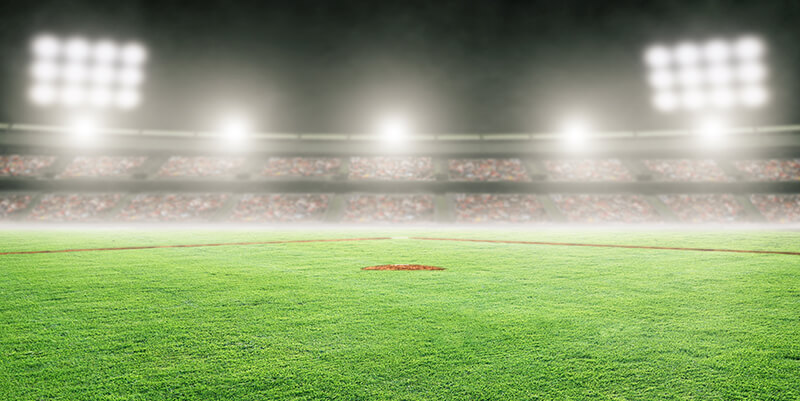
Whether you’re in Wrigley Field or your local high school gym, there’s something kind of magical about sitting under those lights, sharing the excitement and the action with a crowd.
And as large public gatherings resume and sporting events become a regular part of our lives again, we’ll appreciate that experience more than ever. To make it even more amazing (and economical), it may be time for sporting facilities to look at upgrading their lighting.
As a retrofitter, there is a world of business opportunity in ballfields and gyms across the nation. The question is: How can you win more of these deals?
Selling the Value of LED Sports Lighting
Most sports facility managers already know LED lights provide better energy efficiency and significantly lower energy costs. (And if they don’t, feel free to tell them that LED lights can provide energy savings of 65-85% in an outdoor setting.)
But rarely is that benefit alone enough to close the deal. Customers are often balancing competing interests from financial folks, sport directors, school districts, local governments, and communities.
To make a strong case that provides a clear win for the customer, here are some of highest value advantages LEDs offer for sports fields:
No Restart Time
Metal halide (MH) lamps] require a warm-up period of as many as 15 minutes to reach 90% of their full light output. And if it’s turned off, the arc tube must cool down or the lamp won’t restart – even if it had been on for hours.
Imagine a brief power blip in the middle of a game turning into a 15minute blackout, and you have a powerful image to convey to your customer. Solid state LEDs are fully illuminated instantly and don’t require a restart period, so they’re always ready to shine.
LED Fixtures Don’t Depreciate as Quickly
HID lights begin to depreciate after fewer than 10,000 hours of operation (that’s a little shorter than the 1984 White Sox/Brewers game, but not by much).
From that point, a metal halide has a light output that’s only 60% of the original light level. For players, referees, and fans that loss of visibility can be a big problem.
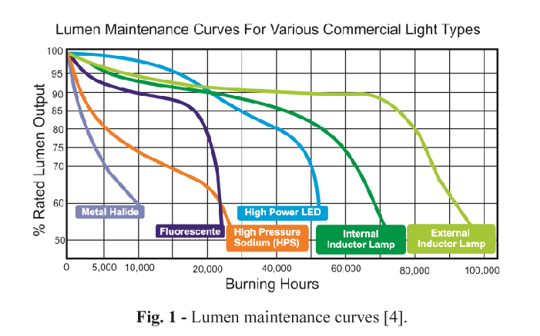
Research shows that an LED high bay lamp or fixture will maintain 70% of its original light output for at least 50,000 hours, and still generate 80% at 40,000 hours.
No Re-lamping Needed
Re-lamping the lights around a sports field means having to send technicians up 100-foot poles every three to five years. Aside from the costs, this type of maintenance operation needs to be planned far in advance, not only to ensure the replacement lamps are on hand but also to avoid interfering with the game schedule. LED lights, on the other hand, never have to be re-lamped.
Less Glare and Better Light Control
Customers paying for light levels and quality want to see it on the field. HID fixtures have more glare, which makes a difference when a player is trying to follow a pop-up ball at a baseball game. Also, many sports fields are in or near residential areas. Light spill will affect the surrounding neighborhood and can be a nuisance to the community.
LEDs have better glare control than HIDs and offer a more focused and precise type of light that gives you more control over where the light goes.
If your customers are balking because of budget, maybe Lighting as a Service can clear those roadblocks and improve your revenue stream. Read about it in our blog, Lighting as a Service: What to Know, How to Succeed.
What Makes Up a Sports Lighting System?
A complete sports lighting system includes luminaires, pole structure, wiring, control systems, and electrical distribution and cables.
Luminaires
The luminaire can have an integral driver or a remote driver. A luminaire with a remote driver will require an enclosure to house the remote. This enclosure is usually located 10 feet above ground level.
Pole Structure
The pole structure is composed of a crossarm, which is where the luminaires are resting, the pole shaft or tube, and the base.
Wiring
A crossarm harness routes the wiring from the fixture to the pole harness, essentially becoming the pole harness. The pole harness is scrolled down into the tube of the pole to the base of the pole where everything is grounded.
Control Systems
Some sports fields may require a control system, some may not. In most cases, that is a remote system located close to the service panel.
Electrical Distribution & Cables
Typically, electrical contractors handle connecting the sports lighting system from the control systems, if any to the service panel.
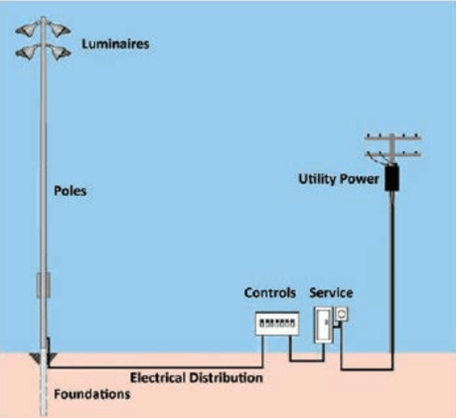
Matching the Sports Lighting System to the Need
How is light level measured on sports fields?
The Illuminating Engineering Society has recommended standards for indoor and outdoor sports lighting. These standards are divided into four different classes, distinguished by type of play and capacity.
Class I is the highest level and would be for professional-league sports facilities like Wrigley Field. Class IV is the lowest level, aimed at high schools, training facilities, and amateur leagues. Another good way to think about it is by considering the number of spectators. A few benches for parents? You’re looking at a Class IV facility. Class III would be the type of facility with seating for a couple of hundred people, typically. Class II is semi-professional, with seating for up to 5,000. Over 5,000 seats? That’s Class I.
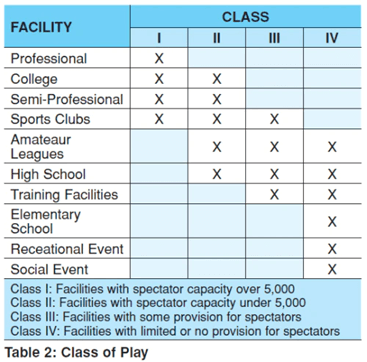
In addition to the amount of FC required, you’ll need to know that each sport field type requires a different lighting layout. For example, to light a football field to a Class IV standard, you only need 30 FC (footcandles) at the field level. For a Class III facility, you’d need 50 FC, and 75 FC for a Class II.
For a baseball field, a Class IV facility would need 30 FC for the infield and 20 FC for the outfield. A Class III spectator capacity facility at the same baseball field would need 50 FC for the infield and 30 FC for the outfield.
You’ll also need to plan for the correct lighting uniformity. Uniformity is presented as a numerical ratio, known as the Uniformity Ratio (UR), between the highest FC measurements and the lowest FC measurements. UR ensures light is evenly distributed throughout the field. For instance, if you have a 200’ x 100’ soccer field, and you need 50 FC on the field, the uniformity requirement according to the IES will be 2:1 (Max:Min).
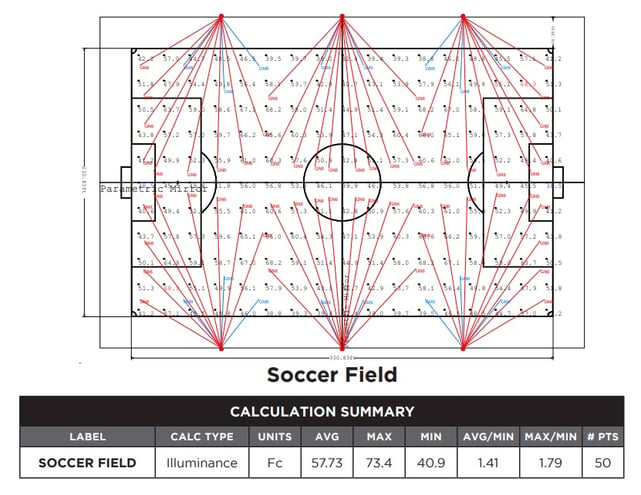
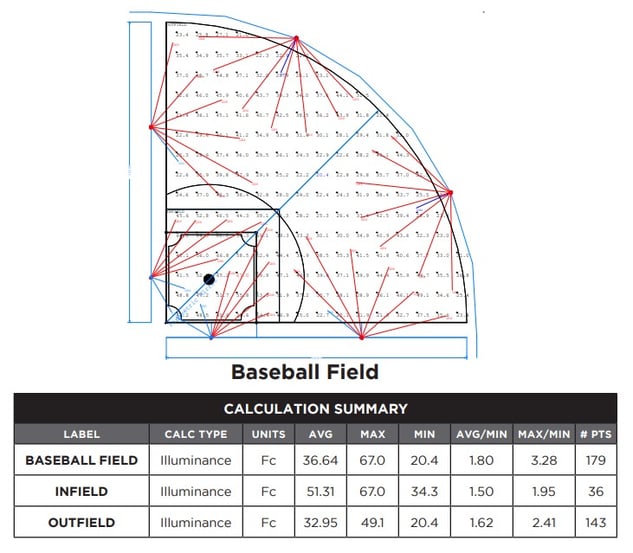 Layout completed using the MaxLite luminaire Fieldmax FL-SR series
Layout completed using the MaxLite luminaire Fieldmax FL-SR series
[source]
There is also the question of whether an LED sports lighting upgrade will be fixture to fixture—using the existing pole structure—or if the lighting demand calls for a new fixture count and a new pole structure configuration. The ultimate lighting layout will depend on the number and height of the poles, the dimensions of the field, and the footcandles and uniformity needed at the playing field level.
Winning a Sports Field LED Retrofit Project
If entering the sports field market is on your strategic to do list, you’ll want to have a comprehensive and streamlined audit, quote and install process to get the most profitability out of those projects.
Companies using SnapCount lighting retrofit software know they’ll have a complete and consistent site auditing process. Having all the audit data and photos instantly digitized makes it fast and easy to turn around a quote that isn’t just accurate, it’s the kind of quote that closes deals.
A high-quality audit pays major dividends during install by ensuring your crew has all the product and information they need to get started quickly and finish on time and budget. That’s the kind of result that generates referrals—putting your business in the winner’s circle.
Set your team up for success in capturing new markets with SnapCount software from Streamlinx. This article: Finding New Market Opportunities in 2020 and Beyond: How Software Is Becoming a Growth Driver for Retrofit Businesses, can give you more ideas. Get it here.






Share this post: